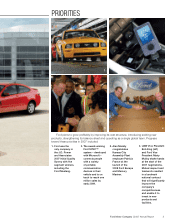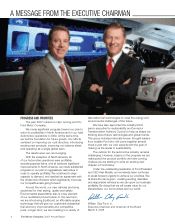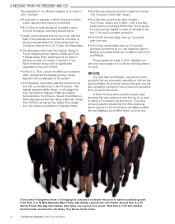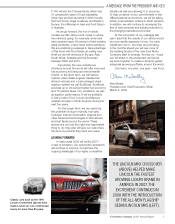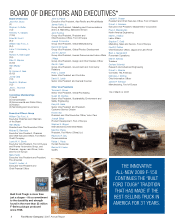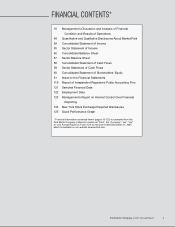Ford 2007 Annual Report Download - page 13
Download and view the complete annual report
Please find page 13 of the 2007 Ford annual report below. You can navigate through the pages in the report by either clicking on the pages listed below, or by using the keyword search tool below to find specific information within the annual report.
Management’s Discussion and Analysis of Financial Condition and Results of Operations
Ford Motor Company | 2007 Annual Report 11
continue to contribute, to the severe pricing pressure in that market. For example, in 2006, Toyota completed construction
of an assembly plant in Texas that is capable of producing 150,000 full-size pickup trucks annually as of 2007, and is
projected to be able to produce 200,000 full-size pick-up trucks beginning in 2008, according to CSM Worldwide. The
reduction of real prices for similarly contented vehicles in the United States has become more pronounced since the late
1990s, and we expect that a challenging pricing environment will continue for some time to come. In addition, the relative
weakness of the Japanese yen against the U.S. dollar, and more substantially against the euro, contributes to Japanese
vehicle manufacturers' significant cost advantage, especially on exports from Japan to these markets. In Europe, the
automotive industry also has experienced intense pricing pressure for several years, exacerbated in recent years by the
Block Exemption Regulation.
Consumer Spending Trends. We expect, however, that a decline in or the inability to increase vehicle prices could be
offset at least in part by the long-term trend of consumers' propensity to purchase higher-end, more expensive vehicles
and/or vehicles with more features. In the United States, for example, consumers in the highest income brackets are
buying more often and are more frequently buying upscale.
Emerging markets will also contribute an increasing share of global industry volume and revenue, as growth in
wholesales (i.e., volume) will be greatest in emerging markets in the next decade. We believe, however, the mature
automotive markets (e.g., North America, Western Europe, and Japan) will continue to be a significant driver of global
industry revenue growth.
Health Care Expenses. In 2007, our health care expenses (excluding special items) for U.S. employees, retirees, and
their dependents were $2.2 billion, with about $1.2 billion for postretirement health care and the balance for active
employee health care and other retiree expense.
For 2008, our trend assumptions for U.S. health care costs include an initial trend rate of three percent. Over the long
term, our steady-state trend rate assumption is five percent, reached in 2011; in any given year, however, the rate could
be higher or lower. These assumptions reflect our ongoing focus on health care cost control (including eligibility
management, employee education and wellness programs, competitive sourcing, and employee cost sharing) and an
assessment of likely long-term trends. They do not include the impact of the recent Memorandum of Understanding with
the UAW relating to retiree health care, discussed in detail in this Overview.
Commodity and Energy Price Increases. Commodity prices, particularly for steel and resins (which are our two largest
commodity exposures and among the most difficult to hedge), have continued to increase during a period of strong global
demand for these materials. In addition, energy prices also continued to increase significantly in 2007. In particular,
gasoline prices in the United States rose to levels over $3.00 per gallon during 2007. Although prices have moderated
somewhat, they are expected to remain at high levels. This has had an adverse effect on the demand for traditional full-
and medium-sized SUVs and trucks in the United States.
Currency Exchange Rate Volatility. The U.S. dollar has depreciated against most major currencies since 2002. This
created downward margin pressure on auto manufacturers that have U.S. dollar revenue with foreign currency cost.
Because we produce vehicles in Europe (e.g., Jaguar, Land Rover, and Volvo models) for sale in the United States and
produce components in Europe (e.g., engines) for use in some of our North American vehicles, we experienced margin
pressure. Although this pressure was offset partially by gains on foreign exchange derivatives, this offset declines over
time due to the expiration of favorable hedges previously put in place. We, like many other automotive manufacturers
with sales in the United States and costs in foreign currencies, are not always able to price for depreciation of the U.S.
dollar due to the extremely competitive pricing environment in the United States.
Other Economic Factors. Additional factors have recently affected the performance of the automotive industry. In the
United States, 2007 was a period of a significant contraction in the housing market. As a result, spending on new
residential construction declined by 16.9% (after inflation). This adjustment had two effects on automotive sales and
revenue – directly, through its adverse effect on GDP growth, and as a contributing factor to potential softer demand for
truck sales. Both of these factors may continue to contribute to lower light vehicle sales in the United States. In addition,
during the second half of 2007, the United States experienced a subprime mortgage contraction that resulted in an
associated contraction throughout the world in other types of credit market activity, which impacted adversely certain of
Ford Credit's capital market funding activities. The contraction of credit market activity appears to be continuing into 2008,
which could result in higher costs of capital and generally reduced economic activity.




